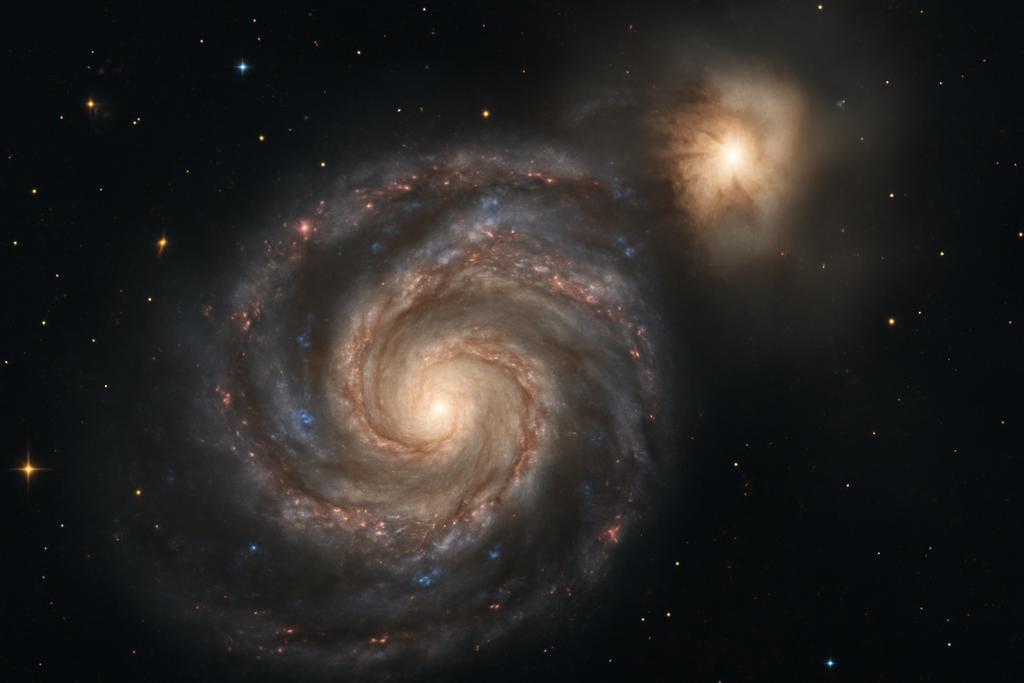Unraveling the Mysteries of Star Formation in the Whirlpool Galaxy
The Whirlpool galaxy (M51), a breathtaking spiral of gas and stars, has long captivated astronomers. Its iconic structure, a grand design spiral with prominent arms, makes it an ideal laboratory for studying star formation. But a new study, based on the highest-resolution observations ever conducted of M51’s dense gas, reveals a surprising twist: our understanding of the very fuel that ignites new stars may need a significant recalibration. The research, conducted by Sophia K. Stuber and colleagues at the Max-Planck-Institut für Astronomie, challenges our conventional wisdom about what molecules reliably signal the presence of dense gas, the birthplace of stars.
The Fuel of Stars: Dense Gas and Its Telltale Signs
Stars are born from collapsing clouds of dense molecular gas. To understand how stars form, astronomers need to locate these dense regions. For years, molecules like hydrogen cyanide (HCN), hydrogen isocyanide (HNC), and formyl ion (HCO+) have been considered reliable markers of dense gas. They’re relatively easy to detect, making them popular choices for large-scale extragalactic surveys.
However, this reliance on HCN, HNC, and HCO+ has been based on extrapolations from observations of our own Milky Way galaxy and lower-resolution observations of other galaxies. These previous studies haven’t always captured the fine details of gas distribution within galaxies. This research uses the unprecedented resolution and sensitivity of the Surveying the Whirlpool galaxy at Arcseconds with NOEMA (SWAN) survey to paint a more precise picture.
A New Standard for Dense Gas Detection: The SWAN Survey’s High-Resolution View
The SWAN survey, a collaborative effort involving multiple institutions across the globe, deployed the Northern Extended Millimeter Array (NOEMA) and the IRAM 30-meter telescope to conduct high-resolution and high-sensitivity mapping of M51’s central region. This yielded detailed maps of several molecules, including HCN, HNC, HCO+, and diazenylium (N2H+). This last molecule is particularly interesting because, in our Milky Way, it’s only found in the coldest, densest regions of molecular clouds where carbon monoxide (CO), a commonly used tracer of the overall molecular gas distribution, freezes onto dust grains.
The exceptional resolution of SWAN (125 parsecs, or roughly 400 light-years) allowed the researchers to analyze the gas distribution not only on large scales (kiloparsecs), but also within individual molecular clouds and across diverse environments within M51. This level of detail has never before been achieved for a galaxy of M51’s size and complexity.
The Unexpected Findings: HCO+ Emerges as a Better Tracer
The study’s surprising finding is that HCO+ proves to be a more reliable tracer of truly dense gas compared to the traditionally favored HCN and HNC. By comparing the emission from all four molecules, the researchers found that HCO+’s emission patterns correlated most closely with that of N2H+, the gold standard for dense gas in our galaxy, while HCN and HNC showed significantly more deviations. The implication is that HCN and HNC may be giving us a somewhat inflated picture of dense gas.
This deviation is not consistent across all regions within M51. The research team divided the galaxy’s disk into distinct regions: the central region (containing the active galactic nucleus, or AGN, and the nuclear bar), the molecular ring, and the northern and southern spiral arms. In the central region, HCN and HNC emissions were significantly stronger than expected relative to HCO+ and N2H+, suggesting that additional physical processes may be at play.
Environmental Factors at Play: AGN and Galactic Dynamics
The study suggests that environmental factors, including the AGN and the overall dynamics of M51 (partially influenced by its interaction with a smaller companion galaxy), might be affecting the ratios of these molecules. The researchers explored several factors to understand these variations, including the surface density of molecular gas, the star formation rate, stellar mass density, the dynamical equilibrium pressure in the interstellar medium, the gas velocity dispersion, and the distance from the galactic center.
Higher ionization rates in the central region could enhance HCN emission, while the dynamical equilibrium pressure, which represents the balance of forces within the interstellar medium, seems to play a role in the distribution of various molecules. The influence of the dwarf companion galaxy on the larger-scale dynamics of M51 is thought to affect the flow of gas throughout the galaxy.
Implications for Galaxy Evolution and Star Formation: A More Nuanced View
The findings of this research highlight the importance of high-resolution observations in understanding galaxy evolution and star formation. Relying solely on HCN, HNC, and HCO+ to trace dense gas may lead to inaccuracies in our models of star formation and the overall evolution of galaxies. The SWAN survey’s results emphasize the need to incorporate a more comprehensive and nuanced understanding of the environmental factors that can affect the emission of different molecules within galaxies.
This study not only refines our understanding of star formation within the Whirlpool galaxy but also provides valuable insights into how galaxies evolve. By revealing the complexities of dense gas distribution, it helps us to build more accurate models of galactic processes. As this is the first high-resolution survey of its kind covering such a large area, it lays important groundwork for future research, urging astronomers to reconsider their traditional assumptions and embrace the sophisticated reality of galaxy dynamics.










